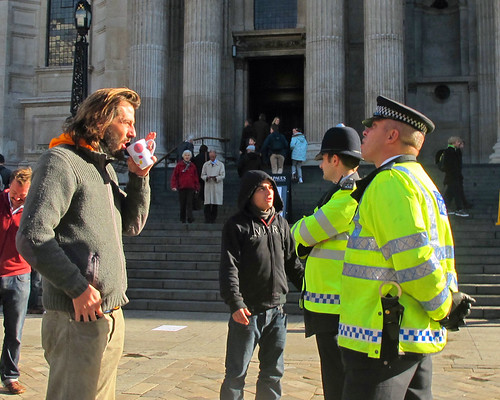On the steps of St. Pauls Cathedral last Saturday, hunched over a cup of tea, the grumbled disdain of a British protester could be heard, “Here we go again, borrowing from America.” Yet while the Occupy movement may have started stateside, protest camps have been around in the UK for years. There is something about the form, the vision, the collective ethos of protest camping that British people find irresistible. And whether or not they know it, those now occupying the square outside St. Paul’s Cathedral are building on a great British tradition.

- photo by: Maggie Jones
The largest and most infamous camp in UK history is Greenham Common. What started in September of 1981 as a peace walk of a strong willed few, swelled to become an international movement. Within two years anti-nuclear camps had begun around the UK at bases in Faslane and Molesworth, as well as across four continents with camps in the US, Canada, The Netherlands, Germany, Italy, Australia, South Africa, Japan and Honduras. The tactics and strategies developed at Greenham Common and in the peace camp movement broke with traditional left styles of organising, centring on creative direct action and non-hierarchical decision-making.
Ten years later protest camps swept through the UK again, this time targeting the building of new motorways.The first of the ‘anti-roads’ camps appeared in Twyford Down in 1992, and soon after protest campers were occupying treetops in Newbury and rows of terrace housing set for demolition in Walthamstow. The rapid growth of these protest camps led to widespread media coverage, as the Economist reported in 1994, “Protesting about new roads has become that rarest of British phenomena, a truly populist movement drawing supporters from all walks of life.”

At the turn of this century the form of the protest camp expanded to large scale anti-summit mobilisations. In the UK, this truly took shape at the Horizone EcoVillage against the 2005 G8 summit in Gleneagles. The camp opened for two weeks providing shelter and food for 5,000 campers while serving as a space to plan and enact protest aimed at the summit.
Building on the Gleneagles experience, climate camp was born in 2006 outside the Drax coal-fired power station in Yorkshire. The camp drew 800 activists, enough to make a marked impression on national media and capture peoples’ imagination. A year later at Heathrow, camp numbers increased to 2,000 for a week long protest against further airport expansion. Following years saw more UK climate camps around the country in Kingsnorth (2008), London (2009) and Edinburgh (2010), and further afield in Canada, the US, Germany, Denmark, France, Ireland, the Netherlands, Belgium, Ghana, Australia and New Zealand.

Photo by: Maggie Jones
This is just a small sampling of British protest camps. In each of these places, camps played a pivotal role, acting as a central base for a broader social movement. What often began as a single camp in a specifically chosen place, spread to neighbouring towns, cities, countries and across continents. While each protest camp is distinct, their organisational structures are similar and their goal of building a better world resonates across time and place.
What makes protest camps irresistible is the unique space they create. In a time when the vast majority of our relationships with strangers are mediated by money, the protest camp is a space for people to come together to talk, share skills and exchange experiences. Alongside this, they are places where conflicts and differences demand accountability and ideologues must compromise for new ideas to grow. The most important thing becomes people’s capacity to listen, to learn from each other. As artist-activist John Jordan explains, ‘When asked how we are going to build a new world, our answer is, we don’t know, but let’s build it together.’

photo by: sk8dancer
With Occupy the London Stock Exchange and smaller encampments in Nottingham, Birmingham and other UK cities now in their second week, and Occupy Finsbury Park continuing to grow, eyes are poised to see if the OccupyTogether model has sticking power across the pond. With current movements against austerity measures already underway, highlighted by the half million strong J30 march last Winter and N9 and N30 strikes and demos planned for November, the sentiments of Occupy Wall St. are certainly shared across the UK. Mix this with a 30 year history of some of the most inspiring and successful protest camps the world has seen and we just might have the recipe for a long-lasting Occupy UK.

Pingback: Warwick University on Occupy London | Protest Camps